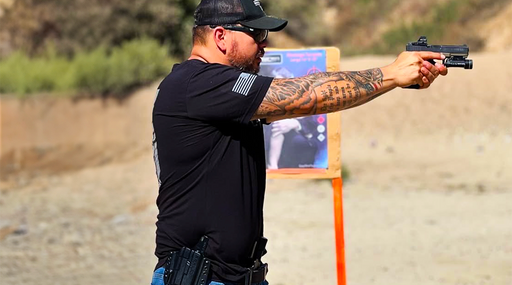
Churches, Temples, Synagogues—the physical and congregational aspects of them—exist within an outside world in which violence is an increasingly common form of problem-solving or personal expression. This has always been the case historically, but many Americans over the age of about 30 are shocked at the thought of violence within sacred spaces. We came up in an era during which violent threats to houses of worship, and the people in them, were virtually unheard of. In recent years, that has changed. Crime directed at faith communities is no longer surprising to anyone who stays aware of such incidents. So, what to do? Anyone reading this post in a gun blog might respond with “get a gun.” But just as with personal protection, security for faith facilities is not that simple.

The purpose of this three-part series is to take a 30,000-foot view of the matter, with the purpose of evoking thought and discussion at your own house of worship. For simplicity, “church” is the term used to cover any house of worship, inclusive of temples, synagogues, mosques, whatever term is used by the religious organization. The vast diversity of churches in the United States is not unlike the range of differences between families. Factors that are critical for one may be spurious for another. So these recommendations are very general, based on experiences I’ve had in conducting vulnerability assessments and providing training and follow-up with congregational teams with several churches, plus providing contract armed guard services for one church in particular.
Identify Likely Threats

Attacks on churches come from a handful of predictable sources. Although there is no rule saying a certain class of violence can’t ever happen at your church, it’s a good idea to devote more planning and resources to preventing likely problems. Here are likely categories of threats, at least in my experience:
Individuals in the surrounding community with severe mental illness or addiction
This is the most common threat, and its timing is often predictable. Fortunately, with a good prevention strategy, most of these threats can be recognized and their ability to harm can be minimized and contained, nearly always while still exercising compassion and allowing for dignity. Modern history shows that risk of a violent attack from this segment of the population is greatest when they’ve recently been told “no” in terms of assistance with money or something closely associated with it. Additionally, individuals who experience potentially harmful delusions or auditory hallucinations commanding them to do harm are to be considered dangerous during that usually brief but dangerous phase of their illness or addiction. When money is of concern, services in which a collection plate is passed or moved from one room to another should recognize that time as a likely one to be targeted. Often, key people in the congregation or the minister/priest/rabbi are targeted at times when they are highly visible and/or gathered in the same place during church services.
Individuals experiencing family conflict with a congregation member
Domestic violence and child custody issues can be at the root of threats that present themselves at church, where family members’ habits and locations are predictable, and where there may be increased access to a child because a teacher isn’t aware of the circumstances. People in the throes of family conflict can be very volatile and willing to exact violence on gatekeepers to reach their real target. While these threats are usually temporary, they are to be taken seriously. Tactful communication between paid and volunteer staff and the potential adult target(s) are key. The “need to know” and confidentiality principles should be exercised judiciously to prevent a security strategy from turning into gossip. A system of limited and supervised physical access, especially to children’s areas, by outsiders is the basis for prevention. A communication strategy for any paid or volunteer staffers noting a potential or unfolding problem is highly recommended.
Groups or individuals with an ideological axe to grind
Fortunately, these are the least common source of violence directed at faith communities. When this kind of attack happens, it is usually exacted upon churches, typically in urban or suburban locations, that have no plan for prevention, escape, or protection. Such attacks are often very bloody; in Europe some have included ritualistic murder. Vandalism of sacred objects is often included in these attacks. Vandalism of sanctuaries during an after-hours break-in is a related risk to the physical church that falls into this category.
Acknowledging the ancient truth that some parties harbor vile feelings for a given religious sect and are willing to do vile things to express those feelings, is the first step in preventing these attacks. While these ugly crimes are nearly always done ambush-style, it’s remarkable how many pre-attack indicators can be identified and risks eliminated with acknowledgement and a little study of the reality of violence. This is, of course, a cultural matter within the church to a large extent.
Make a Plan

Improving safety of congregants and security of the facility should involve three factors These include:
- Harden the target, which means making it more difficult to execute and continue attacks on either people, the facility, or both. Emphasis on the physical plant is implied by the term, but the placement and vigilance of people in sentry and guardian roles is also a hardening factor.
- Staff selection, training, and protocols. What people in sentry and guardian roles do or don’t do makes a huge difference in outcomes. This is often the greatest challenge, as most churches rely on volunteers for this effort. Retired or current law enforcement officers are often recruited for this role and are usually an asset. Civilian members often have applicable skills that can be valuable, too. To expect one officer to be globally proficient and prepared for every situation throughout the facility is neither realistic nor fair, except in the smallest of churches.
- Culture. The culture of the church and community has undeniable bearing on the effectiveness of any security plan. Those who rely on hope and prayer as a primary strategy as well as teams operating under dictatorial leadership styles will, in my experience, be ineffective in preventing or dealing with the immediate aftermath of violence.
In Part 2 of this article, these three factors will be addressed in greater detail. Has your church experienced a potential or verified threat? If so, which of the categories above does it fit into? If any threats repeatedly present themselves, have you observed any patterns in view of seasons, events in the surrounding community, or other things? Let us know in the comments.





















Leave a comment
1 comment
Very good material. I’m a retired officer for almost 40 years but maintain my credentials through the LEOSA act. Our small church is looking at options now and your materials were great.